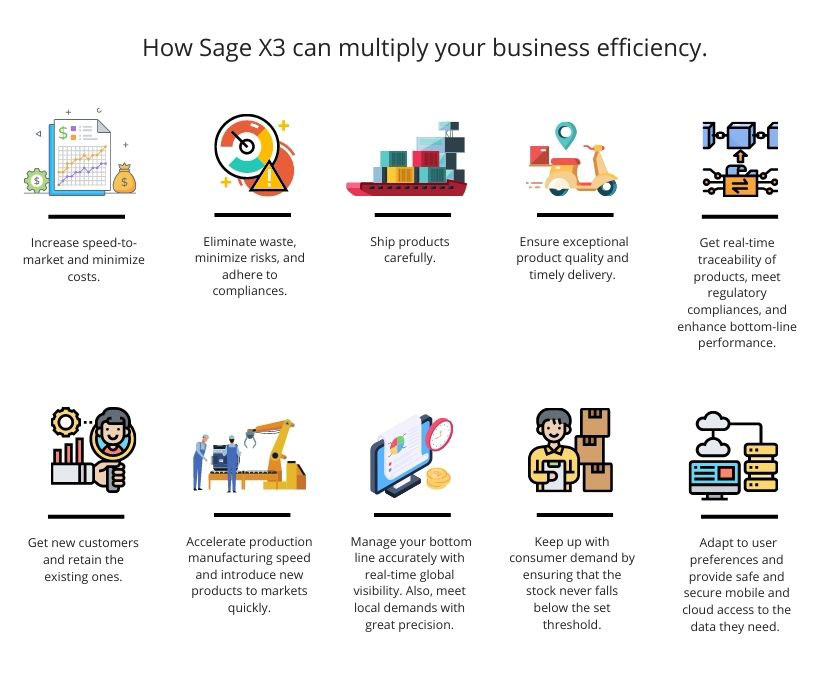Summary: Manufacturing is the process of producing goods by using raw materials, chemicals, formulation, machinery and labour. A survey says that after the pandemic covid 19 digital transformation is the new normal for the manufacturing industry. Discrete and process manufacturing are the two types of manufacturing processes. Both processes have distinct manufacturing operations.
Manufacturing is the process of converting raw materials into finished products by using labour and machinery. The manufacturing process commences with selecting high-quality raw materials. It then undergoes a manufacturing process to produce a finished product for the consumers ultimately.
5 Types of Manufacturing Processes
Manufacturing can be classified into five types –
- Discrete manufacturing
- Process manufacturing
- Repetitive manufacturing
- Job shop manufacturing
- 3 D printing
Here we will be learning about discrete manufacturing and process manufacturing in detail. Some examples of manufacturing industries are the textile, automobile, pharmaceutical, and many more.
Steps of the Manufacturing Process
The manufacturing process comprises a few steps that must be devised and followed. Here it goes-
- First, analyze with your team and enhance your product vision, examine your target audience, find out the necessity of your product to your consumers, and research your competitors.
- Research the demand for your product for consumers, how your product can be improvised to compete against your competitors and define how you can market your product creatively to reach your target audience.
- Next, design the product by keeping the end user at the forefront. Make the product more user-friendly and how efficiently your target audience can use it. Consumers prefer using the easier-to-use product every time. Decide the resources needed, packing, lifespan and cost of the manufacturing.
- At this point, Reassess and finalize the design to send it for the manufacturing process.
- Test your product design before sending it for mass production. Manufacture a few products and take time to assess them and check if it qualifies for the consumer to use safely and efficiently.
- This is the most significant step – manufacturing the product. Calculate the cost of the product, including your profits. Assess the time taken to manufacture and the quantity of raw materials needed.
- Again repeat a few more tests to qualify your product for the consumer to use ultimately. Get feedback to improve.
- The final step is to launch your product to the consumers.
What is Discrete Manufacturing?
Discrete manufacturing is the process of manufacturing all the parts of the product first and then assembling it to form a finished good. Here both the production and the assembling process comes under discrete manufacturing. Some examples of discrete manufacturing are automobiles, mobile phones, computers and many more.
In discrete manufacturing, the production depends on the needs or demands of the customer. The products can later be disassembled into different parts back to their original stage. For example, a car can be disassembled into different parts and then again fixed back into a finished product. Plus, the products can be counted and tracked as units or in numbers.
Benefits of IoT in Discrete Manufacturing
Discrete manufacturing process is evolving rapidly. As a result, we have embedded systems like AI, machine vision, real-time data analytics and computing in the cloud.
Smart factories implement all the advanced embedded systems with IoT to optimize everything from inventory to the customizable manufacturing process. The best example is the automobile industry, where most features can be customizable. With industry 4.0, innovations are done from time to time to make it entirely personalized.
What is Process Manufacturing?
In process manufacturing, formula or recipe is created. This formula or recipe is applied to manufacture the finished product. The product is manufactured with a set of instructions or procedures. Here goods are produced in bulk. The ingredients or the raw materials are combined by adding a formula or recipe, and a finished product is created. The manufactured goods are irreversible. Process-manufacturing products include plastics, pharmaceuticals, food and beverage, and gasoline.
In process manufacturing, the production process more often requires chemical or thermal conversion, like heat, time and pressure. Note that the ingredients, once blended to form a finished product, cannot be disassembled back to their previous state. For example, a medical syrup cannot be broken down and returned to its previous state, separating the ingredients.
Process manufacturing can be further divided into two production types –
- Continuous process manufacturing
- Batch process manufacturing
As the name suggests, continuous process manufacturing continuously manufactures the goods yearly. In contrast, batch process manufacturing is produced based on the customer’s demand. The customer creates an order based on the batch or quantity of goods. After that batch is manufactured, the used equipment is cleaned.
<<<Also read: 10 types of BOM and why they matter?>>>
Discrete vs Process Manufacturing
Process manufacturing and discrete manufacturing are very distinct in nature. In discrete manufacturing, the product can be broken down into its previous state. But process manufacturing is not possible as it uses formulas and recipes to manufacture products.
Process manufacturing employs a bill of materials(BOM) to manufacture the product. Goods produced in discrete manufacturing can be disassembled and recycled.
Process manufacturing can be linked to recipes or formulas, procedures or instructions, blends or mixes, weight or volume measurements, and ingredients. Discrete manufacturing is linked to the bill of materials(BOM), parts and components, fabrication, and identifying parts with numbers.
ERP Software for Process and Discrete Manufacturing
ERP systems are essential for all types of manufacturing. The lifespan of an ERP system is 8-10 years, it is crucial to find a suitable ERP system for your manufacturing industry. ERP software is designed distinctly for each industry suiting its requirements. Selecting an ERP system that comprehends the difference between discrete and process manufacturing is very important.
Deploy an ERP system embedded with highly beneficial and suitable tools for your company. Focus on implementing an ERP system that can streamline and automate your business, integrate your business operations, and provide precise data visibility.
<<<Learn more: The Impact of Poor Inventory Management in Discrete Manufacturing>>>
ERP system for Process Manufacturing
Importance of percentage and ingredients formation
Entering the suitable composition of ingredients in the ERP software is essential. The professionals of the R&D lab enter it. Step-by-step instructions are also recorded to automate the entire manufacturing process to get accurate results. Based on percentage formulation, the ERP system can automate and manufacture goods.
Mixed unit of measure
ERP software is efficient enough to convert any units of measure(ounce, pound, litres etc.). It ensures that the ingredients maintain proportionality. ERP system can convert any standard measurement or metric system to convert to produce accurate results based on percentage formulation.
Batch quarantine and recall through lot tracking
Reliable LOT tracking enables tracking and recall of the product efficiently. The discrete manufacturer has to adhere to all the compliance rules regarding the raw materials and finished goods. It can be maintained up to date using an ERP system. Maintaining the quality of the goods and following the compliance rule is mandatory.
Batch Processing vs Route Step Processing
Batch Processing
Process manufacturers often give detailed instructions with the right proportion of mixing quantities to make a good quality product batch by batch. For example, a batch of cookies can be manufactured by the process manufacturer following all the proportions to meet the quantity and quality expectations of the consumer.
Route Step Processing
Discrete manufacturing functions very differently, they work and add things at different places. For example, a discrete manufacturer crafts a dining table in three different places. He makes the top in Work X, two legs in work B and the other two legs and the finishing in work C.
Sage X3 ERP System
Sage X3 is a leading and trusted ERP software in the industry. It is a comprehensive ERP system integrating all the business processes. The manufacturing industry is of many types. The good part is that our Sage X3 software is embedded with all the best features and can be customized to suit your business needs. It is the solution for all your day-to-day business operations. To learn more about our product, visit our website.
Sage Software Solutions is a leading IT company with an array of advanced ERP Software solutions. Our proprietary products — Sage X3 and Sage 300 will help you cut your operational expenses, improve business productivity, increase operational efficiency, forge robust customer relationships, and strengthen association with vendors, suppliers, and distributors. So, if you are looking to reinforce your business fundamentals and emerge as an industry leader, then please schedule a call with one of our sales representatives.





